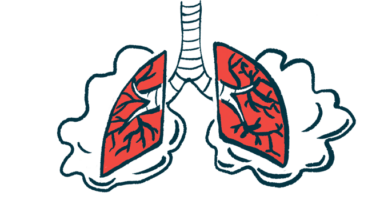Eosinophils Reduce Inflammation, Cell Overgrowth in PH: Study
Scientists say findings could provide future avenues to explore for treatment

Immune cells called eosinophils help protect against the progression of pulmonary hypertension (PH) by reducing lung inflammation and regulating the growth of muscle cells around blood vessels, a new study indicates.
The study, “Eosinophils Protect Against Pulmonary Hypertension through 14-HDHA and 17-HDHA,” was published in the European Respiratory Journal.
Pulmonary arterial hypertension (PAH) is marked by chronic inflammation around the lungs’ blood vessels, though the specific immunological mechanisms driving this inflammation are incompletely understood.
Eosinophils, or EOS, are a type of immune cell that characteristically contain rounded granules. These cells are critical for the immune system’s response against parasites, and they are known to play a disease-driving role in certain lung conditions like asthma. The role of EOS in pulmonary hypertension, however, has been unclear.
To learn more, a team of scientists in China assessed EOS counts in blood and lung tissues from 123 people with PAH, as well as 119 healthy volunteers who were similar in terms of age and sex.
Results showed PAH patients had significantly lower proportions of EOS in their blood, and among PAH patients, EOS counts were generally lower among those with worse functional status. By contrast, PAH patients had higher EOS counts in their lung tissue, and tissue from PAH patients also had elevated levels of signaling molecules needed for EOS trafficking.
“Taken together, these results indicate that EOS migrate [from blood] to lung tissue during the progression of PAH in humans,” the researchers wrote.
Replicating results in mice model
The scientists next tested whether these results could be replicated in a mouse model of pulmonary hypertension, and mice with PH-like disease had significantly lower counts of EOS in their blood but higher counts of EOS and EOS-attracting signaling molecules in their lungs compared to control animals.
To gain greater insight into the role of EOS in disease, the researchers next induced pulmonary hypertension in mice that had been genetically engineered so that they made fewer EOS than normal.
Results broadly showed pulmonary hypertension was more severe in the EOS-deficient mice, with more overgrowth of blood vessel and heart tissue. Similar findings were discovered when an antibody treatment was used to deplete EOS, and consistent results also were found in experiments done in rat models.
“Taken together, these results show that genetically or chemically induced EOS deficiency aggravates PH development, suggesting that EOS have a protective effect in PH development,” the scientists concluded.
Further experiments showed EOS-deficient mice had increased levels of other immune cells (namely macrophages, monocytes, and neutrophils) in their lungs. These results “indicate that EOS deficiency or depletion aggravates the PH-related inflammation of lung tissue in mice,” the researchers wrote.
Other experiments showed EOS could reduce the growth of the muscle cells around blood vessels. PH is marked by abnormal growth of these muscle cells, so “these observations suggest a beneficial role of EOS in regulating [pulmonary artery smooth muscle cell, PASMC] function,” the researchers wrote.
Additional tests indicated one likely mechanism for these effects: EOS releases a number of oxidized fatty molecules called oxylipins. The scientists demonstrated that two of these molecules, 14-HDHA and 17-HDHA, could both reduce the migration of neutrophils, macrophages, and monocytes to the lungs and also reduce the growth of PASMCs.
“These results reveal that EOS exert anti-proliferative effects and anti-inflammative effects via oxylipins such as 14/17-HDHA,” the team wrote.
These findings open potential avenues for new treatment strategies that could be explored in future studies, the scientists noted. For example, the team suggested it may be beneficial to test whether supplements of 14/17-HDHA could help boost levels of these molecules in the lungs to slow disease progression.








